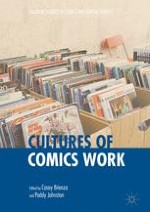Abstract
How are we to understand a work of comic art without any knowledge of the myriad varieties of cultural work that went into its creation, and how might each better inform our understandings of the other? This book is an exploration and interrogation of these two questions. In the comics art world—a world that is still being mapped out and defined with retroactive applications to the comics canon by comics scholars across various disciplines and departmental affiliations—there exists a tendency to canonize the writer and to advance a narrow, auteurist vision of production when analyzing and studying comics. Scholars, cartoonists, and comics fans alike will be familiar with the names of Alan Moore, Osamu Tezuka, Neil Gaiman, Marjane Satrapi, Chris Ware, Alison Bechdel, Carl Barks, Charles Schulz, and Hergé—to name but a few of the names that loom large in the intellectual firmament of comics studies. But they are little to no knowledge of these creators’ collaborating artists, pencillers, letterers, flatters, inkers, cover designers, editors, publicists, typesetters, translators, distributors, or retailers. These roles, an indicative but not exhaustive collection of the duties that can be undertaken in the journey of a comic from its initial germ to the hands of a reader, are, no doubt, work. All of these are roles that can be done in exchange for money and/or goods in the capitalist labor market, and all are examples of what, in the title of this book, we term “comics work.”
